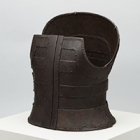Japanese Archaeology and Special Exhibition (Heiseikan) Japanese Archaeology Gallery
September 14, 2010 (Tue) - December 12, 2010 (Sun)
In the Yayoi period, the development of agricultural society saw the advent of war, and weapons were fashioned from hunting equipment. In time, specialized production brought about increasingly efficient metal weapons, to which armor made from wood and other materials emerged in response. Metal armor appeared in the Kofun period, and included imported armor from China and Korea as well as examples made in Japan, based on sophisticated iron forging technologies from continental Asia.
In the early Kofun period, short cuirasses (tanko) appeared, bearing similarities to examples imported to Japan at the time as well as to artifacts unearthed in Korea. In the mid-Kofun period, banded armor developed uniquely in Japan, and while production was concentrated in the Kinai region, the armor itself was distributed over a wide area. The late Kofun period witnessed the spread of continental-style lamellar armor, however beaked helmets, widespread since the mid-Kofun period, continued to be produced.
Excessive embellishment and impractical shapes are frequently seen in arms and armor. These qualities are socially and politically symbolic, and can be said to reflect developed agricultural society. Documents from the fifth king of Wa (the ancient kingdom of Japan) suggest that the preparation of metal armor in the mid-Kofun period was spurred by the military nature of rule at the time. The development of armor of the Kofun period corresponds with the appearance and phasing out of kofun tumuli, making armor an important resource for understanding shifts in modes of combat, culture and social structure during the Kofun period.

